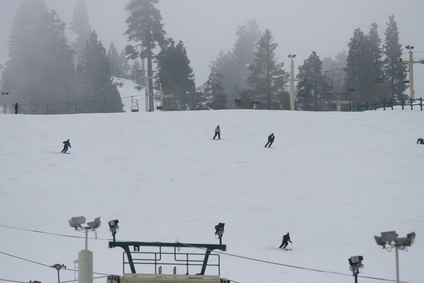
Big Bear is a mountain resort town located high in the San Bernardino Mountains of southern California. Altitudes in parts of the resort exceed 7,000 feet, and severe winter storms often bring deep snow and ice, making the highways and local roads treacherous. It is important to know how and when to use snow chains to stay safe during a Big Bear winter.
Because Big Bear has only a seasonal snow season, there are no year-round requirements for snow-chain use. Snow chains must be used only when the California Department of Transportation, or Caltrans, declares them necessary. Caltrans uses an incremental scale of R1 to R3 to establish chain-control requirements on California roadways.
When a roadway is designated an R1 area, all vehicles must use either snow chains mounted on the tires of the drive axle or snow tires on all four wheels.

When a roadway is designated an R2 area, all vehicles must use snow chains on the tires of their drive axles. However, four-wheel-drive vehicles may use snow tires if they are mounted on all four wheels and the vehicle also carries snow chains for the tires of the drive axle.

When a roadway is designated an R3 area, all vehicles must use snow chains on the tires of their drive axles, without exception. An R3 advisory is rarely declared, because either Caltrans or the California Highway Patrol will usually close a roadway before R3 restrictions can be imposed.

To substitute snow tires for snow chains under R1 and R2 conditions, California law requires that the tires' tread pattern be unusually deep and aggressive. When inspecting tires under R1 or R2 conditions, the highway patrol will require that tires have the letters MS, M/S, M+S or the words MUD AND SNOW stamped on their sidewalls before waiving the chain requirement. Snow tires must have a minimum tread depth of 6/32 inches to be legal.
Passenger cars and trucks must use link-chain devices under R1 and R2 conditions, and any chain design that meets a vehicle's manufacturer specifications is acceptable. Commercial trucks may use cable-type chains, but these trucks may be restricted from operating under certain local conditions..
All vehicles towing trailers must have chains on the tires of one drive axle. This includes four-wheel-drive vehicles.
Trailers with independent brakes must have chains on the tires of one drive axle.
Front-wheel-drive vehicles must have chains on the tires of the front axle.
Semi-trailers require only one set of chains, regardless of the number of axles they have.
No chains are ever required on the tires of a tag axle.